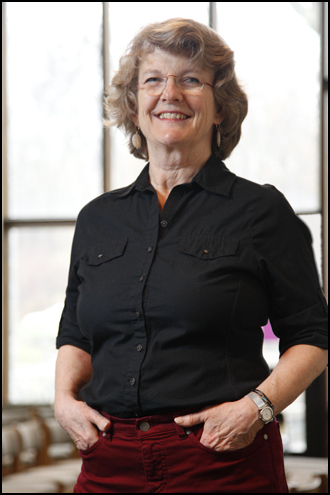For women composers, no more sounds of silence
 Photo/Mike Lovett
Photo/Mike LovettAmelia LeClair
Around the time Shakespeare was writing his play about a couple of crazy kids in Verona, a 14-year-old in Ferrara, Italy, was doing much more than mooning over a Romeo. She was composing passionate songs of love.
And, remarkably, they are as full of pure melody as any tune Paul McCartney has written, says Amelia LeClair, a scholar at the Brandeis Women’s Studies Research Center (WSRC) and director of Cappella Clausura, a chorus that researches and performs music written by women.
The girl, whose name was Vittoria Aleotti, wrote a collection of madrigals that her father, a well-to-do architect, arranged to have published in 1593. LeClair learned of the songs a few years ago when she stumbled upon mid-20th-century transcriptions of them. But the transcriptions weren’t performance-ready. “They didn’t tell you much more than what the notes are and what the words and rhythms are,” she says.
So LeClair created performance editions, adding “markings that tell singers how fast to go, where to take a slight slowdown, where to stretch the tempo and where to compress it, where to be piano or forte, and so on,” she says.
With funds raised via Kickstarter, LeClair and Cappella Clausura recorded the madrigals at a Roslindale, Mass., sound studio. The resulting CD, “Love Songs of a Renaissance Teenager,” was released in February.
For the madrigals’ text, the teenage Aleotti used 18 erotic love poems by a contemporary Italian writer. “There’s a lot of ‘dying’ going on in the poems,” says LeClair, “and dying wasn’t death — it was orgasm.” The music the young girl wrote “fits the words so well. It’s like Italian opera — very passionate. It tells a story.”
Tackling risqué subject matter wasn’t a sign of precocity in Renaissance Italy. “At the age of 14, girls were either married or in the convent,” LeClair says. “People grew up a lot faster because they didn’t live as long.”
But Aleotti was an extraordinarily gifted composer, says LeClair, equal to, if less recognized than, the adult male composers of the day. For the madrigals, which consist of four interweaving voice parts, the girl wrote “melodies all over the place, and they’re really nice melodies. They’re easy. They flow.”
Even before her father had the songs published, Aleotti had rejected marriage and entered a local convent. San Vito was internationally known for its nuns’ music performances, which included instruments women of the day didn’t usually play, like woodwinds, cornetti, trombones and trumpets. The pope attended a performance at the convent. So did Margaret of Austria as she traveled to Spain to marry King Philip III.
Once Aleotti enters the convent, she seems to disappear from the historical record. At the same time, a San Vito nun known as Raffaella begins to be praised by contemporary writers for her exceptional skills as a musician and a composer. Most scholars, LeClair included, believe Raffaella and Aleotti are one and the same person.
A different group of Renaissance nuns — this time from Belgium — inspired an event LeClair and Cappella Clausura are presenting during Brandeis’ 62nd Annual Leonard Bernstein Festival of the Creative Arts, on Saturday, April 26, at 8 p.m. in Bethlehem Chapel. “Illuminations” will celebrate a recently discovered manuscript, the Salzinnes Antiphonal, created in 1554 at an abbey in Liège. The beautifully illustrated book had been hidden away, preserving the pages’ vibrant colors.
Cappella Clausura will perform songs from the antiphonal in period convent dress. High-resolution reproductions of the manuscript will be on display, and period food will be served. “You can walk around the space at your own pace, and read, and see, and taste, and smell, and listen to the music,” says LeClair. “It will be a very interactive and full experience.”
LeClair credits the WSRC for enabling her study of little-known women composers. Accepted as a visiting scholar at the center in 2012, she has just been named a resident scholar there — “so now I get to stick around,” she says with a smile.
Studying women composers is just one part of LeClair’s mission. She also wants them to be heard, so she and Cappella Clausura regularly visit schools and colleges to introduce listeners to “new” music written by women across 12 centuries.
“People need to know these women wrote music,” LeClair says. “This music is not just politically correct — it is beautiful.
“I want to bring it back.”
Categories: Arts





